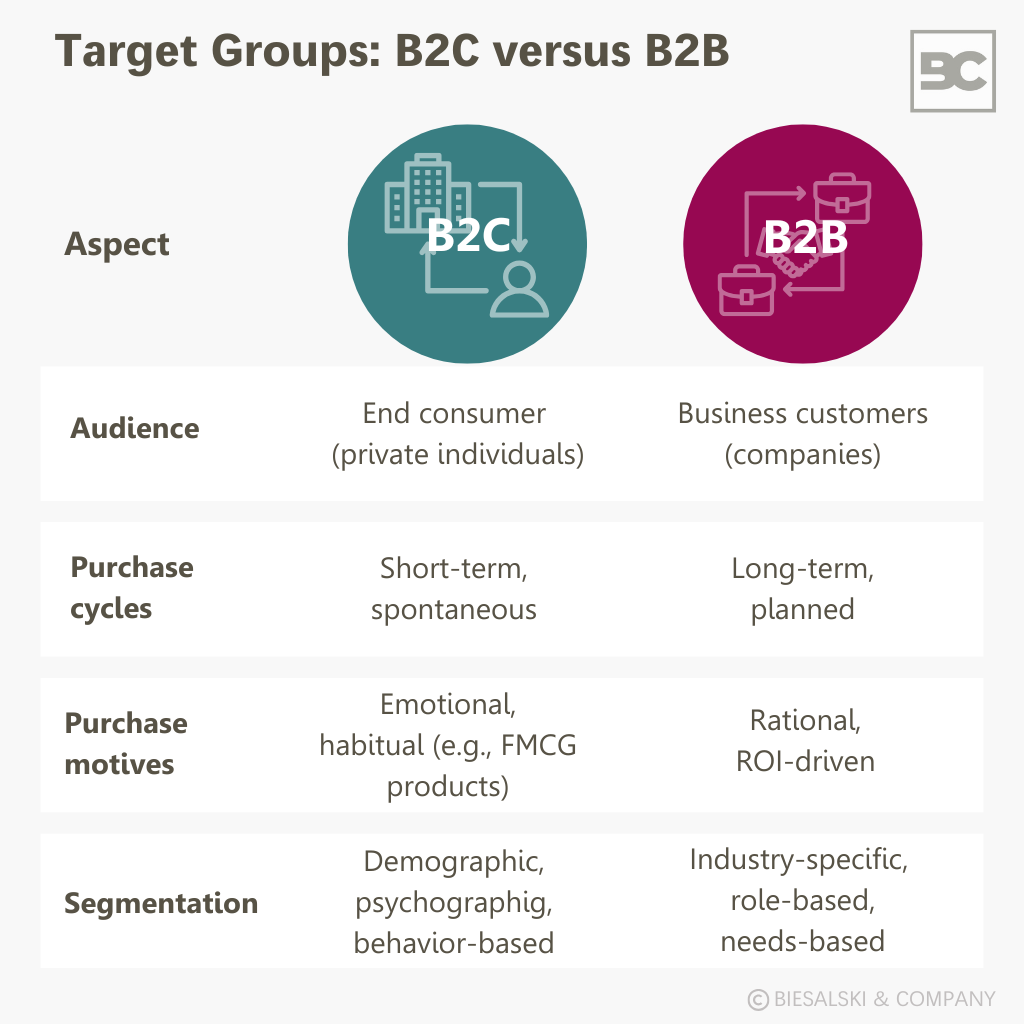Target group
What is a Target Group?
A target group encompasses all potential individuals a company aims to reach and convert through marketing activities for a specific product or service.
In some contexts, the term target audience is also used, especially when the focus is on communication rather than market strategy.
The key lies in identifying a group that is as homogeneous as possible by systematically working out shared characteristics. It is important to note that target groups are not static, but dynamic. They change over time due to technological developments, societal trends, or shifting consumer behaviors. To ensure sustainable success, a target group must be reviewed regularly and adjusted if necessary.
How do I define my target group?
The target group forms the foundation for effective communication and marketing activities. To ensure that these measures are truly targeted, it is crucial to clearly define the common characteristics within the group.
Typically, target groups are segmented based on the following criteria:
- Sociodemographic characteristics: Age, gender, income, education level
- Psychographic characteristics: Values, lifestyle, interests, attitudes
- Geographic characteristics: Region, place of residence, environment (urban or rural)
- Behavioral characteristics: Buying behavior, brand loyalty, usage behavior, price sensitivity
By combining different characteristics, a clear and differentiated picture of the target group emerges, showing the whole customer journey.
Example: Instead of simply defining “men aged between 30 and 40,” a more precise target group could be described as: “Price-conscious men aged 30 to 40 living in rural areas, who are tech-savvy and prefer regional products.”
What are methods for target group analysis?
To define a target group accurately, methods of market research are applied.
Fundamentally, a distinction is made between primary and secondary market research:
Primary market research methods
Here, data is collected directly from the target group:
- Surveys: Quantitative online surveys or qualitative interviews
- Focus groups: Moderated group discussions with 6–10 participants
- Observations: For example, behavioral observations in retail environments or on websites
- Experiments and tests: Such as A/B tests or prototype testing
Secondary market research methods
Here, existing data sources are used:
- Government and industry studies: e.g., Eurostat, Statista
- Academic studies: Scientific articles, papers
- Market reports and white papers
- Competitive analyses
For a comprehensive understanding of a target group, a combination of secondary research and supplementary primary research is often used. This approach makes it possible to capture both general market trends and specific needs and behaviors with greater precision.
How do B2C and B2B target groups differ?
In B2C brands address end consumers directly – that is, private individuals who purchase products or services for personal use. Target group analysis is generally easier in this environment because standardized data, such as age, income, or consumer behavior, is more readily available. The main challenge in heterogeneous markets is to define the target group narrowly enough. The broader and more unspecific the target group, the greater the risk of scatter losses.
In B2B brands, on the other hand, companies address other businesses. These business customers operate within more complex decision-making processes, bring individual requirements, and often compete with one another. As a result, defining a clear B2B target group is significantly more challenging and requires deeper market and industry knowledge. Collecting representative data in B2B target groups often becomes a central challenge, especially in niche markets where reliable data is scarce or difficult to obtain.
In both B2C and B2B markets, knowing the target group is essential for any successful brand strategy. A clearly defined target group forms the basis for tailored messaging, effective media planning, and targeted brand positioning. It also enables companies to allocate resources more efficiently and create sustainable competitive advantages.

In both B2C and B2B markets, knowing the target group is essential for any successful brand strategy. A clearly defined target group forms the basis for tailored messaging, effective media planning, and targeted brand positioning. It also enables companies to allocate resources more efficiently and create sustainable competitive advantages.
Contact
Would you like to schedule a non-binding consultation on this topic? Our experts are available by phone at +49 89 273 73 54 00 or by email at info@biesalski-company.com. You can also find more information about Biesalski & Company’s services in the area of Insights.




